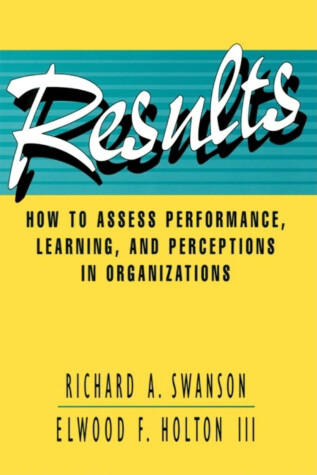The Berrett-Koehler Organizational Performance
1 total work
Results: How to Assess Performance, Learning, and Perceptions in Organizations
by Swanson
Published 13 May 1999
From the author of Analysis for Improving Performance , winner of the 1995 Outstanding Instructional Communication Award from the International Society for Performance Improvement and the 1995 Society for Human Resource Management Book Award
This book presents a practical guide to building a successful, competitive, and cost-effective HRD practice that meets customers' needs. Results teaches readers a highly effective, easy-to-learn, field tested system for assessing organizational results within three domains: performance (system and financial), learning (knowledge and expertise), and perceptions (participant and stakeholder).
Why measure results in HRD? Because the "corporate school" and "human relations" models of HRD practice, whereby development occurs simply because it is good for employees, no longer works. If HRD is to be a core organizational process, it must act like one and hold itself accountable. Measuring results, particularly bottom-line performance results, is key to gaining support from top management. And those who measure results ultimately find it a source of program improvement and innovation as well as pride and satisfaction.
While Results is theoretically sound, it is firmly rooted in practice, offering a core five-step assessment process that gives readers a simple and direct journey from analysis inputs to decision outputs. Whether they have assessment tools but no theory, theory but no tools, or no tools and no theory, this book will equip them to quickly and effectively assess their results.
This book presents a practical guide to building a successful, competitive, and cost-effective HRD practice that meets customers' needs. Results teaches readers a highly effective, easy-to-learn, field tested system for assessing organizational results within three domains: performance (system and financial), learning (knowledge and expertise), and perceptions (participant and stakeholder).
Why measure results in HRD? Because the "corporate school" and "human relations" models of HRD practice, whereby development occurs simply because it is good for employees, no longer works. If HRD is to be a core organizational process, it must act like one and hold itself accountable. Measuring results, particularly bottom-line performance results, is key to gaining support from top management. And those who measure results ultimately find it a source of program improvement and innovation as well as pride and satisfaction.
While Results is theoretically sound, it is firmly rooted in practice, offering a core five-step assessment process that gives readers a simple and direct journey from analysis inputs to decision outputs. Whether they have assessment tools but no theory, theory but no tools, or no tools and no theory, this book will equip them to quickly and effectively assess their results.
